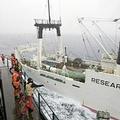 海洋守護協會(Sea Shepherd Conservation Society)史帝夫厄文號的船長保羅瓦特森,在該船駕駛艙中宣佈,他在12月26日清晨遭遇日本日新丸號(Kaiko Mar)捕鯨船。瓦特森說,「日新丸號在濃霧的壟罩下現身於史帝夫厄文號面前。海洋守護協會全體船員隨後追上並且投擲了10瓶腐壞奶油和15瓶甲基纖維素和耐磨的染料混合物。」
海洋守護協會(Sea Shepherd Conservation Society)史帝夫厄文號的船長保羅瓦特森,在該船駕駛艙中宣佈,他在12月26日清晨遭遇日本日新丸號(Kaiko Mar)捕鯨船。瓦特森說,「日新丸號在濃霧的壟罩下現身於史帝夫厄文號面前。海洋守護協會全體船員隨後追上並且投擲了10瓶腐壞奶油和15瓶甲基纖維素和耐磨的染料混合物。」
「這下子,那艘船可說名副其實成了臭酸船」海洋守護協會瑞典籍的二副漢馬斯德(Peter Hammarstedt )這麼戲稱。
甲基纖維素是能溶解於冷水(而非熱水)的白色粉末,並形成黏稠膠狀的凝膠。許多貿易商均有出售,且常添加在食品和美容產品中,作為一種增稠劑和乳化劑。如同纖維素一般,它可食用但不易消化、無毒,且不引起過敏。
這種物質常在電影和電視中廣受使用在用以提供特殊效果,充當骯髒的黏泥巴。
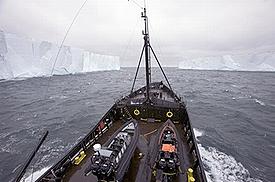 瓦特森說,抗議人士把發臭的奶油和黏性物用力投擲到日新丸號上,主要目的是威嚇日本船隊,迫使他們從澳洲領海向東移動。瓦特森指出,當他們身陷南極海域的冰狀波浪時,兩艘船發生相撞意外。「當史帝夫厄文號朝向日新丸號的右舷側邊來時,捕鯨船員向右舷打滿舵並輕碰史帝夫厄文號,並壓壞部分位於船尾直升飛機坪的保護欄。兩艘船均未受到嚴重的損害。」
瓦特森說,抗議人士把發臭的奶油和黏性物用力投擲到日新丸號上,主要目的是威嚇日本船隊,迫使他們從澳洲領海向東移動。瓦特森指出,當他們身陷南極海域的冰狀波浪時,兩艘船發生相撞意外。「當史帝夫厄文號朝向日新丸號的右舷側邊來時,捕鯨船員向右舷打滿舵並輕碰史帝夫厄文號,並壓壞部分位於船尾直升飛機坪的保護欄。兩艘船均未受到嚴重的損害。」
這起事件發生在莫森半島北邊的澳洲南極洲地區的離岸區。海洋守護協會船員通過澳洲的專屬經濟海域向東追隨捕鯨船隊,一週內橫跨約400英里(約644公里)。在這段時間沒有鯨魚遭殺害。
在12月28日,海洋守護協會發現日本捕鯨船隊,卻突然遭受強烈南極洲風暴(風速達50-60英里/小時)、大風雪、和洶湧大海的侵襲。史帝夫厄文號被迫躲到一個大冰山後暫時避難,同時厚重的冰層卻開始累積在船身四周。
「這是一個不祥之兆。就我們目光所及的周遭全部是巨大的冰體。船長瓦特森花了超過7個小時找出路徑脫困,當時我們以為船一定會壓壞。在這遙遠水域中,那不是非常正面的念頭。」來自英國的船員羅意斯(Steve Roest)說。
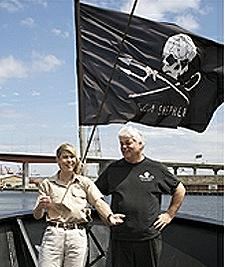 瓦特森表示,「當我們看見房子大小的堅固冰體如同五彩碎紙般地在7至10級的大風浪中翻來覆去,我們真的嚇到了。我必須帶領史帝夫厄文號穿過這些巨大的致命冰體,如果其中一塊擊中我們,船體將會出現破洞且迅速下沉。我不完全有把握會準時到達。當時並未與全體船員告知這一想法。」
瓦特森表示,「當我們看見房子大小的堅固冰體如同五彩碎紙般地在7至10級的大風浪中翻來覆去,我們真的嚇到了。我必須帶領史帝夫厄文號穿過這些巨大的致命冰體,如果其中一塊擊中我們,船體將會出現破洞且迅速下沉。我不完全有把握會準時到達。當時並未與全體船員告知這一想法。」
他描述南極洲海岸如同遙遠、無法預測、威脅人們性命安全,且是個不適合弱者的地方。持續性的守夜來監視天氣和冰面情形是必要的。
瓦特森說,這次穿越冰原航行最具挑戰性的部份,是當史帝夫厄文號抵達公海,必須面對南極海域濤天巨浪的時候。「我們當前的目標是將他們趕出澳洲的專屬經濟海域。我這有一張圖表清楚地說明這些水域屬於澳洲專屬經濟海域。澳洲聯邦法庭明確下令禁止這些船隻在這些海域進行捕鯨活動。我們已告知那些捕鯨人他們罔顧該項法庭裁決。」
日本人聲稱他們進行的是完全合於國際捕鯨會議的規範,是基於科學研究的合法捕鯨行動。位於東京的官方組織日本鯨類研究機構指出,他們的現行捕鯨計畫是基於自我設定的額度,「需要殺死鯨魚的研究計畫,需850頭小鬚鯨魚和50頭長鬚鯨」,另外也有一些非致命性的觀測調查和活體切片取樣。
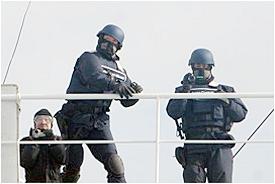 12月26日晚上,探索頻道的動物星球將持續地播放「鯨魚戰爭」影片,該系列是根據海洋守護協會於2007年至2008年間反對日本捕鯨船的運動所拍攝而成。
12月26日晚上,探索頻道的動物星球將持續地播放「鯨魚戰爭」影片,該系列是根據海洋守護協會於2007年至2008年間反對日本捕鯨船的運動所拍攝而成。
瓦特森說他的胸膛在3月7日遭日本海岸警衛隊開了一槍,對方自日新丸號甲板針對史帝夫厄文號船員投擲閃光彈。射彈恰好在瓦特森心臟部位上方爆炸,弄壞了他配戴在防彈背心下的反偷獵鯨魚徽章。
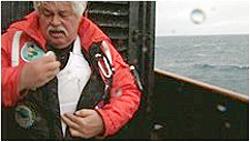 然而當時並未在現場的日本鯨類研究機構董事森本實(Minoru Morimoto)表示,「動物星球把它的觀眾、廣告商,和金錢贊助商當成傻瓜。這個編造、以情節取勝的電視台正透過倉促作業來挽回其日益低落的收視率。動物星球吸收了生態恐怖主義者來為其電視台演出暴力事件。」
然而當時並未在現場的日本鯨類研究機構董事森本實(Minoru Morimoto)表示,「動物星球把它的觀眾、廣告商,和金錢贊助商當成傻瓜。這個編造、以情節取勝的電視台正透過倉促作業來挽回其日益低落的收視率。動物星球吸收了生態恐怖主義者來為其電視台演出暴力事件。」
瓦特森抱怨澳洲政府不允許他的船員穿上去年已穿過的Kevlar防彈背心。「因為砲火的威脅,我決定讓全體船員穿上Kevlar防彈背心,並且請求許可將防彈背心寄交澳洲海關,並於啟程前轉交到船上。這個請求遭拒已直接危害全體船員的生命安全。」
「澳洲政府堅持反對商業和日本所謂的科學捕鯨活動」當日本艦隊於12月上旬時候離港前往南極海域時,澳洲環境部長賈瑞特(Peter Garrett)在一次發言中說道。他指出,該國政府正著手進行「激烈的外交措施」。「我們預期下ㄧ季在南極海域可預見的捕鯨活動將再次吸引海洋守護協會的抗議活動。澳洲政府尊重個人及團體和平抗議的權利。但是不論是何種目標,我們絕不寬恕並譴責任何危險或激烈的抗議活動,包括可能危及海上安全或導致生命損害的任何活動。」
在2008年3月的一場會議上, 國際捕鯨委員會的全部成員ㄧ致要求海洋守護協會克制危險行為,並且要求有關的船隻和船員自制。
「澳洲政府期望任何不合法活動能依據相關國際和國內法律來處理。南極海域是一個遙遠和荒涼地區,任何危機事件的危險性都相對提高許多,營救或者予以協助的能力是相當低的。如同政府過去不斷地重申,我們呼籲各方自制,確保海上安全則是最優先的考量。」格瑞特補充說。
回到東京後,森本實說我們需要引入「常識」來進行商業捕鯨的相關討論。「基於科學研究所獲得的證據,現今世界上許多鯨魚種類的數量豐富和商業性捕鯨可在永續基礎上進行管理,並對於受威脅的稀有品種進行保育,例如藍鯨。鯨魚並未瀕臨絕種,為了確保鯨魚數量繼續增加,讓世世代代永享海洋恩賜,一個商業捕鯨的政體將可能在明日遭取代。」
Captain Paul Watson reports from the bridge of his Sea Shepherd Conservation Society ship the Steve Irwin that this morning he encountered the Japanese whaler Kaiko Maru.
"The Kaiko Maru emerged from dense fog in front of the Steve Irwin," he writes. "The Sea Shepherd crew pursued and delivered 10 bottles of rotten butter and 15 bottles of a methyl cellulose and indelible dye mixture."
"That is one stinky slippery ship," said Sea Shepherd 2nd Officer Peter Hammarstedt of Sweden.
Methyl cellulose is a white powder that dissolves in cold, but not in hot, water, forming a slimy, gooey gel. It is sold under many trade names and is used as a thickener and emulsifier in food and cosmetic products. Like cellulose, it is edible but not digestible, not toxic, and not allergenic.
The substance is popular for use in special effects for motion pictures and television wherever vile slimes must be simulated.
The activists' aim in hurling the smelly butter and slimy goo onto the Kaido Maru was to intimidate the Japanese fleet and keep them moving eastward out of Australian Territorial waters, said Watson.
The two ships collided as they engaged in the icy waves of the Southern Ocean, said Watson.
"As the Steve Irwin came alongside the starboard side of the Kaiko Maru, the whaler steered hard to starboard and struck the Steve Irwin lightly crushing part of the aft port helicopter deck guard rails on the Sea Shepherd ship," he said. "There was no serious damage to either ship."
The encounter took place off the coast of the Australian Antarctic Territory north of the Mawson Peninsula.
The Sea Shepherd crew has been pursuing the whaling fleet eastward for a week across 400 miles through the Australian Economic Exclusion Zone, and during that time no whales have been killed, says Watson.
On Sunday, the Sea Shepherd found the Japanese whaling fleet but was hit at once by a severe Antarctic storm bringing 50 to 60 mile per hour winds, blizzard conditions and heavy seas.
The Steve Irwin was forced to take refuge behind a large iceberg as heavy ice began to build up for miles around the ship.
"It was an ominous sight," said crewmember Steve Roest from the United Kingdom. "All around us for as far as we could sea was a massive pile of ice. It took Captain Watson more than seven hours to navigate a path through it and at times we felt for sure the ship would be crushed, and that is not a very reassuring thought in these remote waters."
"It was a somewhat frightening scene to see hard ice growlers the size of houses being tossed about like confetti in massive swells driven by gale force winds," reports Watson. "I had to thread the ship between those bucking chunks of lethal ice knowing that if just one of them was tossed against our hull, we would be holed and sunk very quickly.
"I was not completely confident that we would make it," he writes, "a thought that I did not share with the crew at the time."
He characterizes the coast of Antarctica as "remote, unpredictable, and hostile to human life and not a place for the faint hearted. A constant vigil must be kept on weather and ice conditions."
The hardest part of maneuvering through the ice field was when the Steve Irwin reached open waters to be met with a massive swell coming from the South, he said.
"Our objective now is to chase them out of Australia's Economic Exclusion Zone," said Watson. "I have a chart here and it clearly states that these waters are Australian EEZ."
"There is an Australian Federal Court Order specifically prohibiting these ships from whaling in these waters. We have informed the whalers they are in contempt of this Court ruling," he said.
The Japanese claim to be conducting perfectly legal whaling that is allowed by the scientific research provision of the International Whaling Commission's treaty language.
Their current whaling program is based on a self-set quota of "a lethal research take of 850 minke whales and 50 fin whales," as well as non-lethal sighting surveys and biopsy samplings from live whales, says the Institute of Cetacean Research in Tokyo, the government agency responsible for the activities of the country's whaling fleet
Tonight, the Discovery Channel's "Animal Planet" features a marathon of episodes from "Whale Wars," the series based on the Sea Shepherd's 2007-2008 battle against the Japanese whalers.
Watson says he was struck by a bullet in the chest on March 7 by the Japanese Coast Guard who Watson says "began to throw flash grenades at the crew of the Steve Irwin" from the deck of the Nisshin Maru, the mother ship of the Japanese whaling fleet. The projectile struck just above Watson's heart and mangled his anti-poaching badge, which was worn on his sweater underneath his bulletproof Kevlar vest.
But Minoru Morimoto, director general of the Institute of Cetacean Research, who was not on the scene, said from his Tokyo office, "Animal Planet is treating its viewers, advertisers and financial backers like fools. This is scripted, plot-driven television motivated by a scramble to reverse sinking ratings. Animal Planet has co-opted ecoterrorists into staging violent incidents for its TV cameras."
Watson complains that the Australian government would not permit him to equip his crew with Kevlar vests last year. "Because of the threat of gunfire, I decided to provide my crew with Kevlar vests and requested permission to have them sent to Australian Customs to be brought onto the ship at departure," he said last March. "The request was refused thus directly endangering the lives of my crew."
"The Australian Government remains resolute in its opposition to commercial and so-called 'scientific' whaling," Australian Environment Minister Peter Garrett said in a statement as the Japanese fleet left port for the Southern Ocean earlier this month. He said the government is undertaking "intense diplomatic engagement."
"We are aware that the coming season's anticipated whaling activities in the Southern Ocean are once again likely to attract protests from the Sea Shepherd Conservation Society," said the minister.
"The Australian government respects the right of individuals and groups to protest peacefully," he said. "But no matter the objective, we do not condone, indeed we condemn, dangerous or violent activities, including any activity that may jeopardize safety at sea or could lead to injury or loss of life."
At a meeting in March this year, all members of the International Whaling Commission collectively called upon Sea Shepherd to refrain from dangerous activities, and called on vessels and crews concerned to exercise restraint.
"The Australian government expects any unlawful activity to be dealt with in accordance with relevant international and domestic laws," said Garrett, adding, "The Southern Ocean is a remote and inhospitable region where the risk of adverse incidents is high and the capacity for rescue or assistance is low. As the government has repeatedly done in the past, we call upon all parties to exercise restraint and to ensure that safety at sea is the highest priority."
Back in Tokyo, Morimoto says "common sense" needs to be brought into the discussions over commercial whaling. "Many whale stocks in the world today are abundant and commercial whaling can be managed on a sustainable basis, while conserving real threatened species - such as the blue whale - based on evidence derived from scientific research."
Whales are not endangered, said Morimoto. "A commercial whaling regime could be undertaken tomorrow in a manner that would ensure whale populations continue to grow and allow current and future generations of the world to enjoy the grace of the ocean forever."






